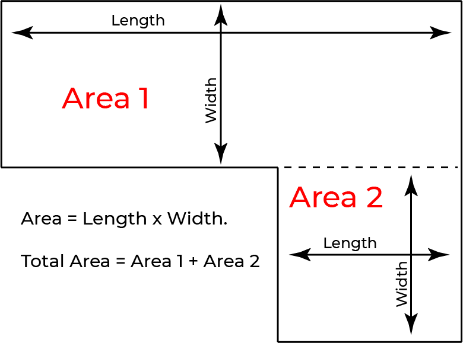How Many Tiles Do You Need to Complete the Floor
Tile Calculator
Updated February 19, 2021
*Includes standard 10% waste.
Before you begin using this simple tiling calculator:
- Measure the length and width of the tiling area – round up to the nearest foot.
- Know the size of the tiles you're using for the project.
NOTE: The calculator automatically adds a 10% waste allowance for cutting and breakage.
On This Page:
- How to Measure for Tile
- How to Measure Tile for a Kitchen Floor
- Tile Layout Calculation and Buying Tips
- How many tiles are in a box?
- How much extra tile should you buy?
- Square Foot Calculator for Tiling
- Does Type Determine How Many Tiles You Need?
- Tile Calculator by Tile Size
- Tile Layout Calculator
- Subway Tile Calculator
- Tiling for Herringbone Pattern Calculator
- Mosaic Tiling
- Ceramic Tile Weight Calculator
- FAQs
How to Measure for Tile
(Room Area/Single Tile Area) x 110% = number of tiles you'll need
- Find the area of the room. Length x Width = Area. Round up to the nearest foot.
- Find the area of a single tile in square feet. Add the width of the grout lines. Square feet = area in square inches divided by 144.
- Divide the area of the room by the area of a single tile.
- Add 10% for waste. Consider adding up to 30% for intricate designs and larger tiles.
- Round up.
How to Measure Tile for a Kitchen Floor
Let's use the following example to demonstrate the use of the above formula for a standard sized kitchen floor.
In this example, we'll use:
A 14-foot long, 12-foot wide kitchen.
10-inch by 10-inch ceramic tile that comes 12 to a case.
An 1/8-inch grout line.
- Room area: 14' x 12' = 168 square feet.
- A single tile area: (10" + 1/8") x (10" + 1/8")
- 10.125" x 10.125" = 102.52. Round up to 103 square inches.
- Convert from square inches to square feet. 103 sq. in. / 144 = 0.72 square feet.
- Divide the area of the room by the area of the tile: 168 square feet / 0.72 = 234 (rounded up).
- Add 10% for waste, or up to 30% for larger sizes or intricate designs:234 x 1.10 = 257.4.
- Round up: 258 total.
- Number of cases you need: 258 / 12 = 21.5.
- Round up: 22 total.
You'll need 22 cases of 10" tile for a 12'x14' kitchen.
Tile Layout Calculation and Buying Tips
Keep these things in mind when measuring, buying and installing.
- Walls are almost never straight, nor square. You won't start a line of tile against a wall. The strip along a wall will almost always need cutting.
- Don't forget grout lines. The smoother the edge, the thinner the grout line you can use.
- Size of tile dictates waste. Larger tiles mean more waste.
- <12"x12": 10%
- >16"x16": 20%+
- Patterns increase waste. Intricate and multi-size patterns create more waste.
- Always round up. When you measure the area, round up to the nearest foot.
- Don't forget accent borders. An accent border usually has one row, so measure the linear feet of it and divide by a single tile length, in feet.
- For 6"x12" tiles with a border of 30 feet = 30 tiles.
- Countertops and backsplashes require a wide variety of trim pieces. Have a professional designer or contractor pick these out or seek help at your local home improvement store.
- Get designs from the same batch. Make sure you can purchase enough of the size and design you want from the same lot number. Different lots might have slightly different coloring and patterns.
How many tiles are in a box?
There are anywhere from 6 to 48 per box with 20 to 50 boxes per pallet. Most often, you'll find 6 to 12 per box or case for tiles bigger than a square foot. Smaller types, like subway and glass, can have as many as 48 per box.
- Sample cases have anywhere from 1-10 per box, depending on size.
- Depending on the size, type and brand, you'll pay $10-$200 per case.
- Cases cover anywhere from 10 to 20 square feet total.
- Pallets cover anywhere from 300 to 1,000 square feet total.
How much extra tile should you buy?
You should purchase between 10% and 20% more tile than you'll need. For multiple size designs, mosaics and large tiles, you might even need up to 30% more. This accounts for breakage and waste. Have more tiles on hand for larger types. Breaking a 2-foot by 2-foot (2'x2') piece wastes far more than breaking a 2-inch by 2-inch (2"x2") piece.
Ready to start your Tile Project?
Find Pros
Square Foot Calculator for Tiling
To find the square feet for tile, you'll need to measure the area of the room, wall or ceiling you're tiling. For multiple areas, measure each and add them together.

Knowing the size of the space you're tiling helps you calculate the square feet needed. Simple area calculations mean multiplying the length times the width of the room. However, odd shaped rooms, cabinetry and windows for backsplashes means doing it a little differently.
- Break up oddly shaped rooms into square areas.
- For kitchens with cabinets, measure the whole room first then subtract the area of the cabinetry.

- Floor Tile Calculator: Multiply the length times the width, then divide by the area of the tile. Since most come in inch measurements, you'll need to divide square inches by 144 to find square feet.
- Shower Tile Calculator: Calculate each wall, ceiling and floor individually, then add together. For multiple sizes or murals, consult a shower tile professional near you.
Calculate Tiles Needed for a Bathroom: Bathrooms often receive numerous types, sizes and designs in the same area. Before calculating the layout, you'll need to understand the intricacies of installing bathroom tile and the different bathroom wall tile design options.
- Measuring a Backsplash for Tiles:Measure the wall's height times the width. For unique kitchens, call a kitchen remodeling professional near you.
- Roof Tile Estimator: Roof tiling costs $7,000 to $19,000 on average. Due to pitch, overlap and designs, you'll need to use our specialized roofing calculator.
Pool Tiles Measurement
For pool tiles, find the area of the bottom and sides separately and then add them together. Don't forget to add the coping and decking into the measurements. Pool tiling costs range from $2,000 to $70,000.
- For square or rectangular pools: find the area of the bottom and add it to the area of each side.
- For oddly shaped pools like lagoons: It's best to hire a professional pool tile installer near you.
- For round pools: measure the circumference and multiply by the height, then add in the area of the bottom. To find the area of a circle, use this formula:
Area = pi times the radius squared
A = π *r²
Area = 3.14*radius²
Ready to start your Tile Project?
Find Pros
Does Type Determine How Many Tiles You Need?
The type you purchase has little to do with how many you'll need. A one square foot ceramic takes up the exact same space as a one square foot granite. However, this comes with one caveat: the cut can affect spacing. The more uniform the sizes, the smaller you can make the gaps between each tile.
- Rough cuts: ¼-inch or more gaps. Requires larger grout lines to keep them straight. The smaller the tiles, the more grout needed.
- Standard cut: 1/8-inch grout. Most common size.
- Rectified tiles: 1/16-inch grout lines. This type has perfectly uniform dimensions and require almost no space between.
Besides the precision cuts, there are a variety of pros and cons to consider for each type.
Tile Calculator by Tile Size
| Size (inches) | Square Feet |
|---|---|
| 2×2 | 0.03 |
| 3×6 | 0.125 |
| 4×4 | 0.11 |
| 4×24 | 0.67 |
| 6×6 | 0.25 |
| 6×8 | 0.33 |
| 6×36 | 1.5 |
| 6×48 | 2 |
| 8×10 | 0.56 |
| 12×12 | 1 |
| 12×24 | 2 |
| 16×16 | 1.78 |
| 18×18 | 2.25 |
| 20×20 | 2.78 |
| 24×24 | 4 |
Ready to start your Tile Project?
Find Pros
Tile Layout Calculator
Calculating layout means increasing waste from cutting. Once you lock in a pattern, you're going to have to buy multiple boxes of multiple sizes. Estimate an extra 5% to 30%, depending on the pattern you choose.
Add the following amounts to your initial calculations for a rough estimate on how much you'll need:
- Herringbone & 2 size patterns: 5%-10%
- 3 sizes: 10%-20%
- 4 sizes: 15%-30%
Designing intricate patterns, planning and purchasing is best left to the pros. Either hire an interior designer who specializes in tiling or hire a tiling installer near you.
Subway Tile Calculator
Subway tiles uniquely come in a 1:2 ratio, usually 3 inches by 6 inches. Subway tile costs $600 to $1,500 on average. It's a rectangular high-gloss white ceramic with a clean and classic look. You can use it in a traditional offset pattern, stacked or herringbone.
Tiling for Herringbone Pattern Calculator
Add an extra 10% waste for a herringbone pattern made from scratch. For premade backsplash sheets, you may only need 5% more. Because it's installed at a 45-degree angle, you'll end up cutting more off the edge than a simple grid design.
Mosaic Tiling
Mosaic tiling covers as much or little space as you and your designer want. The best way to see how much of reach color and type you'll need is to talk to an artist or interior design professional near you.
Ceramic Tile Weight Calculator
| Material | Average weight per square foot |
|---|---|
| Ceramic | 4 lbs. |
| Stone | 6 lbs. |
Expect most commercially available tiles to range from 5 to 7 pounds per square foot, not including mortar. The Tile Council of North America notes that most tile weights after installation depend heavily on the underlayment, materials and thicknesses. With mortar, a square foot may weigh 20 pounds or more. Make sure your structure can handle the extra load.
FAQs
How much tile do I need for a wall?
You'll need enough tile to cover the area of your wall. Multiply the height by the width, then divide by the area of a single tile. Some walls, like bathrooms, often get a half wall covered. Always only measure to the highest installation point.
How many 12×12 tiles do I need for 100 square feet?
You'll need 100 tiles minimum. With waste, expect to purchase 110.
How many 12×12 tiles come in a box?
You'll get 8 to 10, 12×12 inch tiles in one box.
How much do tilers charge?
Tilers charge $4 to $14 per square foot for flooring and $25 to $32 per square foot for countertops and backsplashes. Find out more about hiring a certified professional tiler before you call for quotes.
Ready to start your Tile Project?
Find Pros
How Many Tiles Do You Need to Complete the Floor
Source: https://www.homeadvisor.com/r/ceramic-tile-calculator/
0 Response to "How Many Tiles Do You Need to Complete the Floor"
Post a Comment